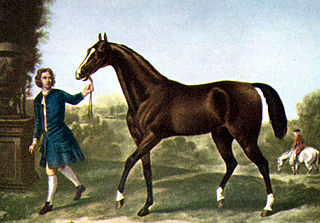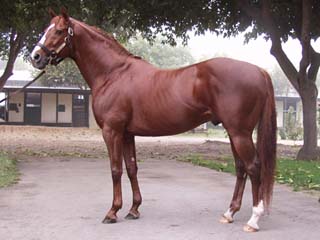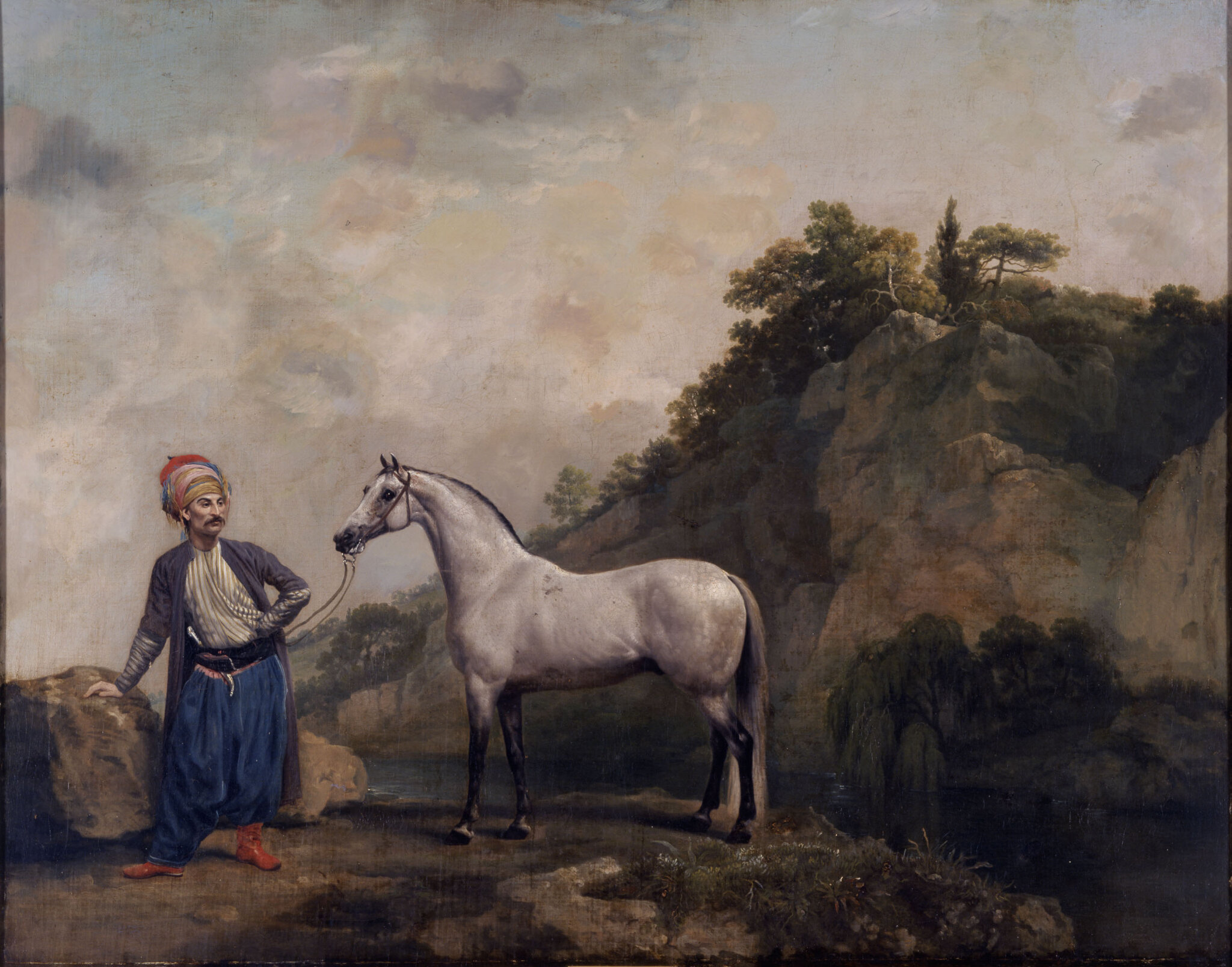Related Research Articles

The Darley Arabian was one of three dominant foundation sires of modern Thoroughbred horse racing bloodstock. The other two founders were the Godolphin Arabian and the Byerley Turk. This bay Arabian horse was bought in Aleppo, Syria, by Thomas Darley in 1704 and shipped to Aldby Park in England, as a present for his brother.

The Byerley Turk, also spelled Byerly Turk, was the earliest of three stallions that were the founders of the modern Thoroughbred horse racing bloodstock.

The Godolphin Arabian, also known as the Godolphin Barb, was an Arabian horse who was one of three stallions that founded the modern Thoroughbred. He was named after his best-known owner, Francis Godolphin, 2nd Earl of Godolphin.

Eclipse was an undefeated 18th-century British Thoroughbred racehorse who won 18 races, including 11 King's Plates. He raced before the introduction of the British Classic Races, at a time when four-mile heat racing was the norm. He was considered the greatest racehorse of his time and the expression, "Eclipse first, the rest nowhere" entered the English vernacular as an expression of dominance.

Birdcatcher (1833–1860), or Irish Birdcatcher, was a Thoroughbred racehorse and a leading sire.

Spark was a Thoroughbred stallion who was among the early imports of Thoroughbred horses to America. The Belair Stud stables were associated with him and a mare, Queen Mab, also imported in this period. Frederick, Prince of Wales gave the stallion to Samuel Ogle, the governor of Maryland, as a gift.

The Thoroughbred is a horse breed developed for horse racing. Although the word thoroughbred is sometimes used to refer to any breed of purebred horse, it technically refers only to the Thoroughbred breed. Thoroughbreds are considered "hot-blooded" horses that are known for their agility, speed, and spirit.
Fenian was a Thoroughbred racehorse who won the 1869 Belmont Stakes. Bred by August Belmont, Fenian raced as a two-year-old, winning two races, placing second twice, and third once from five starts. As a three-year-old he only raced once, in the Belmont, which he won. He suffered from bad legs and some accounts state that he never raced again after the Belmont, although he appears to have raced later as a gelding, and eventually ended up in England where he did some steeplechase races. His likeness is atop the trophy for the Belmont Stakes.

Waxy was a British Thoroughbred racehorse that won the 1793 Epsom Derby and was an influential sire in the late eighteenth and early part of the nineteenth century. Waxy was bred by Sir Ferdinando Poole and was foaled at Lewes in 1790. He was sired by Pot-8-Os, a son of the foundation stallion Eclipse, whose genetic lineage traced to the Darley Arabian. Waxy's dam, Maria, was sired by the influential stallion Herod and produced one full-brother to Waxy, who was named Worthy. Waxy derived his name from a variety of potato, a choice that was inspired by his sire's name. Trained by Robert Robson, Waxy won nine races out of 15 starts during his four-year racing career, retiring from racing at the age of seven in 1797 after sustaining an injury during his last start.
Young Eclipse was a Thoroughbred racehorse that won the 1781 Epsom Derby. He raced until he was six years old, winning seven races and retiring to stud in 1785. He was not a successful sire.
Assassin was a Thoroughbred racehorse that won the 1782 Epsom Derby. His breeder, Lord Egremont, won the Derby for the first time with Assassin. Assassin raced until he was a five-year-old and was retired to Egremont's stud in Petworth. He was not a successful sire.
Aimwell was a British Thoroughbred racehorse. In a career that lasted from autumn 1784 to spring 1786, he ran eight times and won five races. In 1785, he won the sixth running of the Epsom Derby as well as three races at Newmarket. He was beaten in his only race in 1786, and did not appear in any subsequent records.
Noble was a British Thoroughbred racehorse and sire. In a career that lasted from May 1786 to May 1788 he ran at least three times and won two races. He won the seventh running of The Derby as a 30/1 outsider in what was probably his first race. His only other success came at Newmarket later that year. He was retired to stud where he stood as a stallion for several years but made little impact as a sire of winners.

Alcock's Arabian, also known as Pelham Grey Arabian and less certainly as Bloody Buttocks and Ancaster Turk, among other names, is the ancestor of all grey-coloured Thoroughbred horses, as well as grey sport and riding horses descended from Thoroughbred lines.
Americus, was an American Thoroughbred racehorse who was exported to England. He had some success as a racehorse, but was more notable for his influence at stud. He was bred in California and won the 1895 Culver Stakes prior to his export. He continued to race in England, until he was nine years old, while also standing as a breeding stallion. He stood at stud in Italy, Ireland, Germany, and Belgium before dying in Germany in 1910. Americus' most famous descendant was his great-granddaughter Mumtaz Mahal.
Bartlett's Childers was an important Thoroughbred sire in the 18th century.
Bloody Buttocks was a British Thoroughbred sire who was the leading sire in Great Britain and Ireland in 1739. He was owned by Mr. Crofts.
Hollandoise, or alternatively Hollandaise, (1775–1782) was a grey British Thoroughbred mare that won the 1778 St. Leger Stakes, the first horse to win the event under its formal title. Raced sporadically from 1778 to 1782, Hollandoise won eight races in 14 starts. She died suddenly shortly after her last race in 1782 before producing any offspring.
Bourbon was a British Thoroughbred racehorse that won the 1777 running of a race that would later be called the St. Leger Stakes.
Imperatrix was a British Thoroughbred racehorse. She raced only twice, with her only win coming in the 1782 St. Leger Stakes. She was bred and owned by John Pratt. As a broodmare, Imperatrix produced nine foals.
References
- 1 2 "The Old Dominion: Where American Thoroughbred Horse Breeding Began". www.horseracingbusiness.com. Retrieved 22 October 2017.
- 1 2 3 4 "Darley Arabian". www.bloodlines.net. Retrieved 22 October 2017.
- ↑ Harrison 1929, p. 79.
- ↑ Pick, William; Johnson, R. (1803). The Turf Register and Sportsman & Breeder's Stud-book. A. Bartholoman. p. 13.
- 1 2 "Arbitrator" [pseud.] (29 June 1905). "The American Thoroughbred". The Sportsman . p. 8. Retrieved 22 October 2017.
- ↑ Harrison 1929, p. 81.
- ↑ "Oileán Baoi/Dursey Island". Logainm.ie.
- ↑ Ó hÓgáin, Dáithí (1999). The Sacred Isle: Belief and religion in pre-Christian Ireland. Boydell & Brewer. pp. 27, 58.
- 1 2 Ó hÓgáin, Dáithí (1991). Myth, Legend & Romance: An encyclopaedia of the Irish folk tradition. Prentice Hall Press. pp. 165–166, 154.
- ↑ Monaghan, Patricia (2004). The Encyclopedia of Celtic Mythology and Folklore. Infobase Publishing. p. 135.
- ↑ Koch, John T. (2006). Celtic Culture: A historical encyclopedia . ABC-CLIO. pp. 601, 1133.
- 1 2 Harrison 1929, p. 77.
- ↑ Edgar, Patrick Nesbitt (1833). The American Race-turf Register, Sportsman's Herald, and General Stud Book. p. 23. Retrieved 23 October 2017.
- ↑ Skinner, John Stuart (1834). American Turf Register and Sporting Magazine, Volume 6. J.S. Skinner. p. 433.
- ↑ Harrison 1929, p. 78.
- ↑ "Arbitrator" [pseud.] (29 June 1905). "The American Thoroughbred". The Sportsman . p. 461. Retrieved 22 October 2017.
- 1 2 Harrison 1929, p. 80.